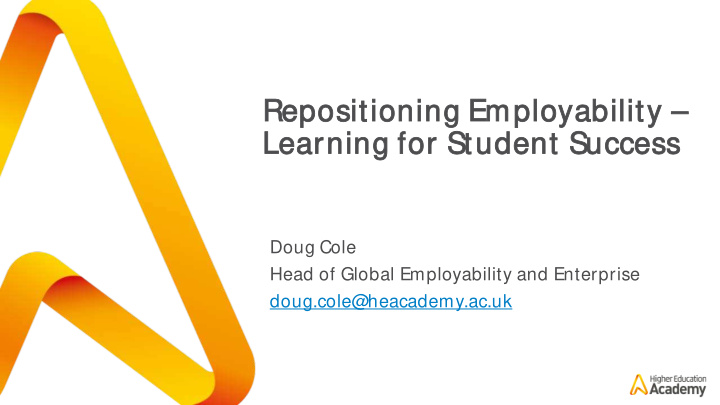



Reposit itio ionin ing Emplo loyabilit ility – Learni ning ng f for Stud udent nt S Suc uccess Doug Cole Head of Global Employability and Enterprise doug.cole@heacademy.ac.uk
2
What does it t take to be s successful? 3 24/05/2017
Are we speaking the sam e language? 4 24/05/2017
More re t tha han n jus ust a a job! ‘E ‘EMPLO LOYMENT’ ’ NOT ‘E ‘EMPLO LOY ABILITY’ 5 24/05/2017
Learning from research in em ployability? Despite the use of the term ‘employability’ at the highest level, it still rem ains a contested term used in a range of contexts (Hillage & Pollard, 1998). Philpott (1999) describe employability as a ‘buzzword’ which is often used but which is interpreted in a num ber of ways Gazier, (1998:298) (Cited in McQuaid & Lindsay, 2005:197) states em ployability is ‘ a fuzzy notion, often ill-defined and som etim es not defined at all.’ 6 24/05/2017
Em ployability: what is it? Examples of m odels used within higher education institutions in UK Kumar (2007) Knight & Yorke (2004) Dacre Pool & Sewell (2007) 7 24/05/2017
What does the research tell us? We have a number of definitions and models We describe how we ‘do it’ There is very little in relation to the praxis describing how these two areas connect This is where the HEA Em bedding Em ployability in HE Fram ework has value 8 24/05/2017
What more can we do? Largely an ‘ ad-hoc’ approach of Work placem ents for every student disconnected activities Internships in the UK and overseas Is provision consistent for all students? Enterprise projects / com petitions Enterprise Societies What is m issing? Em bedded work related learning What do they all have in com m on and Career Managem ent – CV advice, interview how can we engage all staff? preparation, writing cover letters Live projects and briefs Com m unity projects Industry consulted on course design THEY AR ARE AL ALL AB ABOUT Guest lectures and industry panels LEARNI NING NG Alum ni networks and partnerships Em ployer / Industry Advisory Groups 9 24/05/2017
Em ployability and Enterprise - challenges Perceptions and interpretations Engagement (Staff, Students and Industry ) ALL students and joining up the dots Reaching Career Development Learning (for all students) Work – Related / Experiential Learning (for all Personal students) Measuring impact Academ ic Career 10
11 24/05/2017
Repositioning em ployability - ‘ Dimensions for Learning ’ Narrow discourse Narrow teaching Narrow learning Broader discourse Broader teaching Broader learning 12 24/05/2017
13 24/05/2017
A bank of m etrics for em ployability / learning Increase in Industry Psychometric and EQ tests links/collaborations/activity Reflective journals, logs, portfolios Number and percentage of students Alumni case studies engaged in work-related learning (e.g. core m etric) Professional accreditations Percentage of students accessing careers External awards/recognitions support (e.g. core m etric) Student awards / the HEAR Survey results i.e. student career Student retention confidence, satisfaction etc. Stakeholder feedback 14 24/05/2017
Questions to take away If employability is fundamentally about learning, is it tim e to rethink and refram e this agenda? Could you develop a culture that supports learning in its broadest sense? That extends well beyond subject knowledge but that is still defined and explicit in its direction? Could you work collaboratively with colleagues, your students, industry and other stakeholders to define this direction and learning for success? Could you commit to one university approach to this learning design that is flexible enough to be shaped by individual program m e areas? How could you support students to recognise and articulate their learning across a range of contexts, both in the curriculum and beyond, yet still understand how this com es together to support their individual success? Are you ready to start talking differently about employability to help realise the changes needed? 15 24/05/2017
Thank you doug.cole@heacadem y.ac.uk 16 24/05/2017
Recommend
More recommend